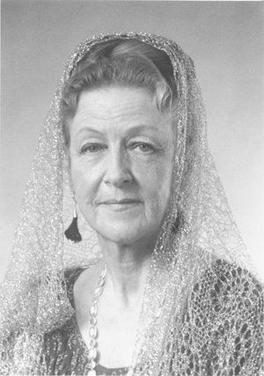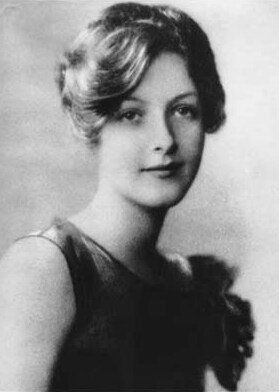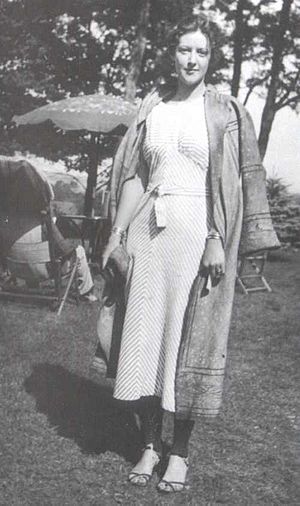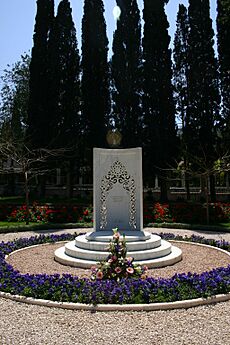Rúhíyyih Khánum facts for kids
Quick facts for kids
Rúhíyyih Khánum
|
|
|---|---|

Amatu'l-Bahá Rúhíyyih Khánum
|
|
| Born |
Mary Sutherland Maxwell
08 August 1910 |
| Died | 19 January 2000 (aged 89) |
| Nationality | Canadian |
| Known for | Hand of the Cause of God |
| Spouse(s) | |
Amatu'l-Bahá Rúhíyyih Khánum (born Mary Sutherland Maxwell on August 8, 1910 – died January 19, 2000) was a very important person in the Baháʼí Faith. She was the wife of Shoghi Effendi, who led the Baháʼí Faith from 1937 to 1957.
In 1952, she became a "Hands of the Cause". This was a special role to help spread and protect the Baháʼí religion. After her husband passed away in 1957, she played a key part in leading the faith until 1963.
Rúhíyyih Khánum grew up in Montreal, Quebec, Canada. She visited the Baháʼí holy places in Haifa, Israel, twice. She was very active in youth groups within the Baháʼí community. After her husband's death, she was the last living link to the family of ʻAbdu'l-Bahá. He led the Baháʼí Faith from 1892 to 1921. He was also the eldest son of Baháʼu'lláh, who founded the Baháʼí Faith. In 2004, people in Canada voted her number 44 on a list of "greatest Canadians".
Rúhíyyih Khánum also wrote several books. These include Prescription for Living and The Priceless Pearl.
Contents
Early Life and Education
Rúhíyyih Khánum was born in New York City on August 8, 1910. Her parents were William Sutherland Maxwell and May Maxwell. She grew up in Montreal, Quebec, where her father was a famous architect. Her family had roots in Scotland and England.
In 1912, ʻAbdu'l-Bahá visited Canada. He stayed at the Maxwells' home. He met Mary when she was two years old. He called her the "essence of sweetness" and showed her much kindness.
Mary's mother wanted her to have a flexible education. She started the first Montessori school in Canada at their home. Mary attended this school. She learned to read and write at a young age. She enjoyed writing poems, novels, and plays. She could speak English, French, German, and Persian very well.
As a young person, she visited the Baháʼí World Centre in Palestine twice. These trips were called pilgrimages. The first trip was with her mother. The second was when she was fifteen, with her mother's friends. On these trips, she first met Shoghi Effendi. He was the leader of the Baháʼí Faith at that time.
Youth Activities in North America
Mary was very active in Baháʼí events when she was young. At age 15, she joined a group called the Executive Committee of the Fellowship of Canadian Youth for Peace. She also helped with local events for racial equality, including dances. One person who saw her, Sadie Oglesby, said Mary was "a beautiful and most refreshing girl".
By age 21, she was chosen for the Local Spiritual Assembly of Montreal. This was the local Baháʼí governing group. Mary was seen as charming and a good speaker. She quickly became a well-known member of the Baháʼí community in North America. She often traveled across the United States and Canada to share information about the religion.
Starting in 1932, she gave talks about a book called The Dawn-Breakers. In May 1933, when she was 22, she visited Washington, D.C.. She insisted that all meetings there should be open to both black and white people. Mary gave talks at Howard University. She worked hard to connect with African-Americans interested in the Baháʼí Faith. She also attended official events with her father in Montreal. She met important people like the Governor General of Canada.
Time in Europe
As a young woman, Mary really wanted to learn Spanish. But her plans to travel to Spain were stopped by the Spanish Civil War. Instead, Mary decided to live with her cousin in Nazi Germany in 1935. Shoghi Effendi supported this choice. In Germany, Shoghi Effendi encouraged Mary to help the small Baháʼí community grow. Mary fit in well with German culture. She wore a dirndl and learned to speak German fluently.
While in Germany, Mary received an invitation from Shoghi Effendi. He asked her and her mother to go on pilgrimage. Both accepted. They had planned to travel through the Balkans. But problems in that area made them go straight to Haifa.
Marriage to Shoghi Effendi
Mary had spent time with Shoghi Effendi before they married. She first met him when she was 12. After a pilgrimage three years later, they kept in touch often. In January 1937, Mary and her mother arrived in Haifa. Shoghi Effendi and Mary began a quiet courtship. By February, they were engaged. Mary quickly sent a message to her father to join them.
On March 24, at age 26, Mary married Shoghi Effendi. It was a simple ceremony. At this time, Shoghi Effendi gave her the title "Amatu'l-Bahá Rúhíyyih Khánum". Amatu'l-Bahá means "Handmaiden of Glory". Shoghi Effendi's mother, Ḍíyáʼíyyih, sent a message to the Baháʼí world about their marriage:
Announce Assemblies celebration marriage beloved Guardian. Inestimable honour conferred upon handmaid of Baháʼu'lláh Ruhiyyih Khanum Miss Mary Maxwell. Union of East and West proclaimed by Baháʼí Faith cemented. Ziaiyyih mother of Guardian.
As Rúhíyyih got used to life in the East, the newlyweds traveled to Switzerland. Shoghi Effendi showed his young wife his favorite places there. It was hard for her to adjust to her new home at first. She felt lonely and missed home sometimes. With Shoghi Effendi's encouragement, she studied the Bible and the Quran. She also started learning Persian. She later became fluent in Persian. She could even give talks in the language. A year after her marriage, she wrote to her mother. She said that if anyone asked her life's theme, she would say, "Shoghi Effendi".
Important Roles and Leadership
Soon after her marriage, Rúhíyyih Khánum became Shoghi Effendi's secretary. From 1941 to 1957, she was his main secretary for English matters. In 1951, she was appointed to the International Baháʼí Council. This was a new Baháʼí group. It was created to help prepare for the Universal House of Justice. It also helped connect the Council with Shoghi Effendi.
Later, on March 26, 1952, she was given the title of Hand of the Cause of God. This was a very important role in serving the religion. In this role, she worked on spreading and protecting the Baháʼí Faith.
After Shoghi Effendi died in 1957, she became a very special person for Baháʼís. She was the last living link to the family of ʻAbdu'l-Bahá. He led the Faith from 1892 to 1921. He was also the eldest son of Baháʼu'lláh, the Faith's Founder.
Leading the Faith (1957-1963)
In 1957, her husband, Shoghi Effendi, passed away. He had not chosen someone to lead after him. Rúhíyyih Khánum was one of 27 Hands of the Cause. These Hands guided the religion for six years. This was until the Universal House of Justice was elected in 1963.
The Hands voted among themselves. They chose nine people to work at the Baháʼí World Centre. These nine were called the Custodians. Rúhíyyih Khánum was chosen for this group. During this time, she worked to finish a ten-year plan. Shoghi Effendi had started this plan in 1953. When the Universal House of Justice was elected in 1963, the Custodians finished their work.
Global Travels and Impact
From 1957 until her death, Rúhíyyih Khánum traveled to over 185 countries. She worked with millions of Baháʼís around the world. She especially encouraged indigenous (native) people to join the global Baháʼí community. Her journeys took her to all continents and many small islands. Some of her trips lasted a long time.
For four years, she traveled 58,000 kilometers (about 36,000 miles). She drove a Landrover through sub-Saharan Africa. She visited 34 countries. In 19 of these countries, she met with the head of state. On another trip, she visited almost 30 countries in Asia and the Pacific islands. This trip lasted seven months. From January to March 1970, she crossed Africa from east to west. She drove two-thirds of the way herself. She visited many communities and met with Baháʼí and government leaders.
In 1975–76, she traveled by boat through the Amazon River in Brazil. She also visited the high mountains of Peru and Bolivia. She visited 36 tribal groups over six months. This trip was called The Green Light Expedition. It followed her earlier trip, The Great African Safari. Other projects have come from these trips, like In the Footsteps of the Green Light Expedition.
During her travels, she met with many leaders. These included:
- Emperor Haile Selassie of Ethiopia
- Malietoa Tanumafili II of Western Samoa
- Prime Minister Indira Gandhi of India
- President Félix Houphouët-Boigny of Côte d'Ivoire
- President Carlos Menem of Argentina
- Prime Minister Edward Seaga of Jamaica
- Javier Pérez de Cuéllar, Secretary-General of the United Nations.
Passing Away
Rúhíyyih Khánum passed away on January 19, 2000. She was 89 years old. She died in Haifa, Israel. She was buried at the Baháʼí World Centre.
Books and Films
Rúhíyyih Khánum was also an author. She wrote several books, including:
- The Priceless Pearl: This book is a biography of Shoghi Effendi.
- Twenty-Five Years of the Guardianship
- Prescription for Living: This book talked about how to use spiritual ideas in daily life.
- The Desire of the World: Materials for the contemplation of God and His Manifestation for this Day
She also edited a book called The Ministry of the Custodians. She made two full-length documentary films: The Green Light Expedition and The Pilgrimage.
See also
- Maxwell International Bahai School




